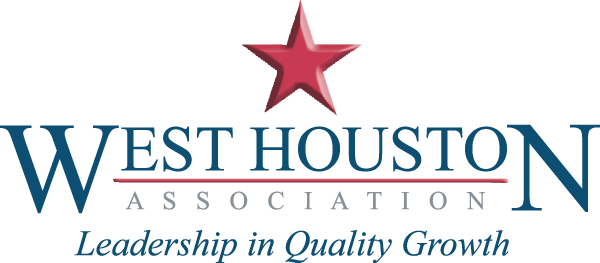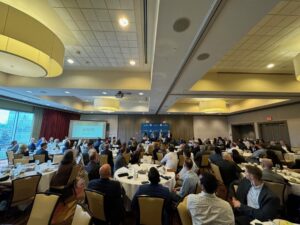
“Ten years ago, when we began to see more green development seminars going on in this area – they were fairly small and few and far between. Seeing the number of people, we have in the room, and the people interested in sustainable infrastructure is really exciting to me.”
– Natalie Chaney, Chair, WHA Sustainable Infrastructure Committee
On Thursday, February 15, 2024, at our “The Marketing Value of Green Development” forum, any doubts about the lack of interest in sustainable infrastructure were quelled, as over 130 people were in attendance. The forum featured David Hogue, Johnson Development Corporation’s Vice President and General Manager of Harvest Green, Scott Snodgrass, Founding Partner of Meristem Communities and Agmenity, and Ray Guerra, Chief Infrastructure Officer for Harris County Precinct 4. Our moderator, past Chair of WHA’s Sustainable Infrastructure Committee, Mark Gehringer (R.G. Miller Engineers | DCCM), presented questions to the panelists about their work in making communities more sustainable and their insights into the impact of these developments.
Alan Steinberg, WHA’s CEO/President, got the forum started by stating that the aim was to help people learn about what’s happening in the space of sustainable infrastructure and how we adopt these principles. He also recognized the ongoing work of WHA’s Sustainable Infrastructure committee and introduced the chair of the committee, Natalie Chaney (RPS Group). Natalie touched on how sustainable infrastructure provides financial and environmental benefits and makes a community more resilient.
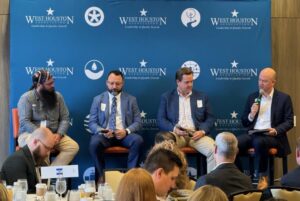
Mark Gehringer began by asking the panelists about sustainability in their work. They discussed David Hogue’s role in the development of Harvest Green – a Master Planned Community in Fort Bend County – and Hogue explained how they incorporated myriad bioswales, trees, and greenspaces in this neighborhood. Ray Guerra talked about Harris County Precinct 4’s use of the Envision framework for sustainability and resiliency, and how the precinct will use these guidelines for future projects even if not going after Envision certification. Scott Snodgrass spoke on Meristem’s Master Planned Community “Indigo;” discussing how it focused on potable and aquifer water conservation and incorporated systems for water reuse. Doing this not only reduces their environmental impact but also helps make the community more resilient against challenges like water scarcity. He also shared why walkability and reducing car use are so important in his work, stating, “the biggest impact that we can have is probably in the planning of our streets – the mixing of the uses, the types of living arrangements that we’re offering, so that people can reduce their vehicle miles traveled.”
Gehringer then asked the panel about their motivations for starting a green development project. Hogue said the incentive for Harvest Green was in creating an “agri-hood” by having a community that grows its produce, which he says, “Over time we’ve grown that, we’ve got edible planting throughout the community.” He added that sustainability was another main consideration, saying that “Coming up with the name Harvest Green, we decided to embrace some additional green aspects like the bioswales.” Snodgrass discussed that for Indigo, they wanted to increase walkability by increasing density, while still maximizing greenspace, resulting in about 60% of the community being green and having open spaces. Gehringer asked Guerra about what the county is incorporating from private developers when it comes to sustainability, and he replied that they consider the best ways to work with regulations and optimize spaces by consulting with experts and focus groups.
The discussion then turned to the impact of COVID and the Winter Storm Uri. Hogue stated that more people have been using trails and green spaces since COVID. Snodgrass explained how Uri made them prioritize community resiliency. Indigo included a focus on solar-powered energy and batteries for critical community buildings, and measures to reduce food wastage. Snodgrass also addressed how a sustainable community can increase property values because access to nature and walkability are highly sought-after amenities. This concept was echoed by Guerra when he added, “The property value for residential and commercial spaces that were the highest had really high walkability scores, they really had a lot of these sustainability amenities that have been alluded to here… it’s both economically beneficial for the folks on the revenue side, but it’s also economically beneficial for the folks that are using the amenities.”
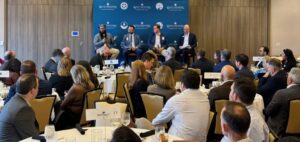
The topic then moved to agriculture. Hogue mentioned how Harvest Green transitioned from community-led gardens to hiring full-time farmers. He stated that, “We wound up engaging Scott [Snodgrass] and Agmenity to run our farm full-time… I believe we have 3 or 4 employees out there on a full-time basis working the crops. We’ve got hundreds of rows of vegetables constantly in production, and we’d come up with about 30,000 lbs. of harvest last year… it’s just a great opportunity for the community to learn about farming and food production.” Gehringer and Guerra talked about bringing agriculture to food deserts, and Guerra stated that they have ongoing, precinct-wide studies to try to tackle this issue. He explained the importance of identifying the specific needs of each community to determine how best to support them – whether that’s with more farms, supermarkets, or something else. Perhaps in the future, we will see agriculture being incorporated into communities more, as a resource for the local populations.
Gehringer’s final question for the panel was about their vision for 2060. Snodgrass discussed reduced reliance on cars and improved understanding of flooding to best direct resources. Guerra proposed increases in green energy production as part of the region’s overall energy leadership. He also spoke on a future with communities that are more walkable regardless of housing affordability. He stated “Houston has the most linear miles of hike and bike trails in the country, I think… but we’re so spread out that sometimes it’s hard to feel that. I think by 2060, sidewalks are just ubiquitous and everywhere, and we have communities that have some of the highest walkability scores in the country… but also… that we haven’t caused green gentrification, so all communities are benefiting from the sustainability and resiliency efforts.”
During an audience Q&A, Alan Black (Quiddity) asked about ways that the public and private sectors can collaborate on green developments. The panel noted some challenges that come with working with local jurisdictions but said they have worked with them on groundwater production, approving smaller lot sizes, and using regional facilities for things like flood control measures. Then, Auggie Campbell asked about the impact of using purple pipes to conserve water, and the panel noted that there are high upfront costs for installation, but also long-term savings, notably because decreased groundwater use leads to lower disincentive permit fees. Snodgrass proposed making purple pipes a requirement for MUDs in the future, stating, “I’d be interested to see this in any MUD that has its own wastewater treatment plant. Does it become a requirement of MUDs, eventually? Because long term those disincentive fees are going to fall on the residents of the community… It’s more expensive for the developer… I think making it a requirement at some point of MUDs is probably how you get to the point where everybody is doing it.”
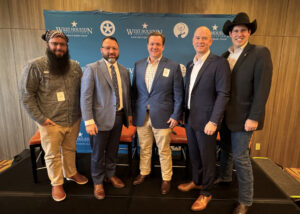
The final question was on the impact of having smaller lots in an area, and Snodgrass brought up the idea that the more taxable value there is per street, the more financially resilient that community is, so long as there isn’t excessive density. Steinberg then wrapped up the forum by encouraging attendees to keep the conversation going about sustainable infrastructure and communities.
Thank you to Natalie Chaney, Mark Gehringer, Scott Snodgrass, David Hogue, and Reynaldo Guerra for their involvement in this event, and to all of you for continuing the conversation about green developments. We would also like to thank our sponsors for making this event possible!
Learn more about our upcoming events by clicking here!
